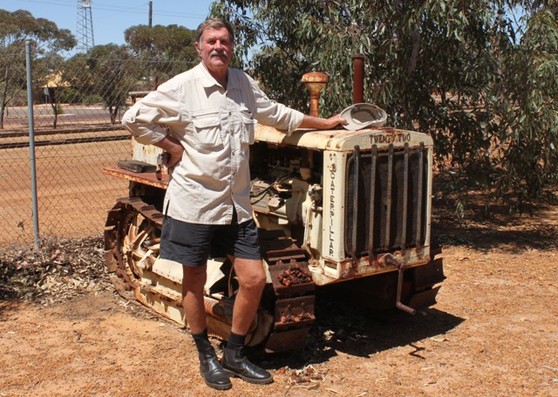
“Go to Mukinbudin,” said a Wongan Hills chap who wandered up at the seaside town of Guilderton. “It has a really great community feel.”
He was curious about Isabel; we were heading out into the wheat belt and wanted to know his suggestions. We had never heard of "Muckinboodin" but followed his advice and 300 km north-east of Perth we fell in love with the little town, its people, its caravan park and swimming pool complex a couple of blocks from the main street.
The rocks to rival Wave Rock were a bonus. So was Bill Crook, secretary of the Mukinbudin Community Workshop where retirees run a 1950s era wheat farming enterprise.
For $12 a night you can stay on an unpowered site in the caravan park ($25 for powered), get free entry into the newly refurbished Olympic pool right next door, use the freshly tiled shower and toilet ensuites and cook in the sparkling, well provisioned new camp kitchen.
A welcoming young couple, Luke and Tania Sprigg, manage the park and pool complex that would do any sizeable city proud. For a town of 400, it is superb – but that’s what you get when a state ploughs some of its mining profits back in communities under the “Royalties for Regions” program, aided by some state lottery funds.
We keep asking the question: “What happened to Queensland’s coal royalties?” Sadly, the regions saw precious little of that wealth that seems to have been spent on two decades of propaganda, public service growth and south-east corner indulgences.
Little Mukinbudin is a delight. The pub’s beer is cold. People are proud of their town and happy to let you know it. The spotless caravan park has neat cabins and four rustic converted railway barrack huts as well as the camping sites.
Luke and Tania are “Muka” farming folk, although they spent some time up north in Kununurra before the humidity drove them home. They are happy to raise their three young children in their home town, although Luke has a hankering to get back on the land and implement some innovative farming practices.
Looking into the past on farming instead of ahead is the Mukinbudin Community Workshop where a dozen retired blokes, some nearing 100, have preserved the past with restoration of machinery and preservation of the 60-year-old farming hub.
On the second day at the caravan park, 80-year-old Bill limped up to invite us to inspect the men’s shed opposite the pub where an assortment of retired Muka blokes restore old tractors, harvesters and farm machinery. They use it to plant and harvest crops (barley is being grown this year) on 300 acres of land just out of town.
Bill, friendly, charming and knowledgeable, is a driving force among the men, most in their 80s and a couple in their 90s. One 86-year-old bloke’s health was not so good but he didn’t want to stop his restoration work at the shed even though his wife worried about him being there sometimes on his own. Bill solved the problem by arranging for the machine under restoration to be taken to the yard of the restorer. He didn’t say what the wife thought of the solution.
WA’s state lotteries commission has funded the community workshop that is not only keeping a bunch of retired blokes happy and active as they painstakingly restore the old machinery, including the oldest working harvester in Australia. It is also preserving a working wheat harvesting heritage for Australia.
Seed is donated but fertiliser is not and at $1100 a tonne that can be a headache for the little groups’ finances.
Some of the machinery is housed inside the three bays of the shed, 120m by 15m-plus verandas. The rest is in the outside yard where Tony was delighted to find an old 22 Caterpillar crawler, the same as the first tractor he ever drove (above).
Bill knows his Muka farming stuff: his family has been around the area for 140 years. The land was opened for selection in 1910 and cleared with axes. Allocations were for 2000 acres but banks would not lend money unless farmers agreed to farm with a third in crop, a third fallow and a third in pasture.
Hay had to be put in first. “If you didn’t have enough feed for your 14 horses – that was the minimum you needed – then you weren’t in it,” says Bill firmly, pointing out a 110-year-old International harvester that needed five horses to pull it. Precious were the teams: a lead horse took five years to train.
Mukinbudin has lots more – like three huge rocks, one that is claimed to be better than Hyden’s Wave Rock and another that has the largest rock water catchment in Australia. But that’s another story.
He was curious about Isabel; we were heading out into the wheat belt and wanted to know his suggestions. We had never heard of "Muckinboodin" but followed his advice and 300 km north-east of Perth we fell in love with the little town, its people, its caravan park and swimming pool complex a couple of blocks from the main street.
The rocks to rival Wave Rock were a bonus. So was Bill Crook, secretary of the Mukinbudin Community Workshop where retirees run a 1950s era wheat farming enterprise.
For $12 a night you can stay on an unpowered site in the caravan park ($25 for powered), get free entry into the newly refurbished Olympic pool right next door, use the freshly tiled shower and toilet ensuites and cook in the sparkling, well provisioned new camp kitchen.
A welcoming young couple, Luke and Tania Sprigg, manage the park and pool complex that would do any sizeable city proud. For a town of 400, it is superb – but that’s what you get when a state ploughs some of its mining profits back in communities under the “Royalties for Regions” program, aided by some state lottery funds.
We keep asking the question: “What happened to Queensland’s coal royalties?” Sadly, the regions saw precious little of that wealth that seems to have been spent on two decades of propaganda, public service growth and south-east corner indulgences.
Little Mukinbudin is a delight. The pub’s beer is cold. People are proud of their town and happy to let you know it. The spotless caravan park has neat cabins and four rustic converted railway barrack huts as well as the camping sites.
Luke and Tania are “Muka” farming folk, although they spent some time up north in Kununurra before the humidity drove them home. They are happy to raise their three young children in their home town, although Luke has a hankering to get back on the land and implement some innovative farming practices.
Looking into the past on farming instead of ahead is the Mukinbudin Community Workshop where a dozen retired blokes, some nearing 100, have preserved the past with restoration of machinery and preservation of the 60-year-old farming hub.
On the second day at the caravan park, 80-year-old Bill limped up to invite us to inspect the men’s shed opposite the pub where an assortment of retired Muka blokes restore old tractors, harvesters and farm machinery. They use it to plant and harvest crops (barley is being grown this year) on 300 acres of land just out of town.
Bill, friendly, charming and knowledgeable, is a driving force among the men, most in their 80s and a couple in their 90s. One 86-year-old bloke’s health was not so good but he didn’t want to stop his restoration work at the shed even though his wife worried about him being there sometimes on his own. Bill solved the problem by arranging for the machine under restoration to be taken to the yard of the restorer. He didn’t say what the wife thought of the solution.
WA’s state lotteries commission has funded the community workshop that is not only keeping a bunch of retired blokes happy and active as they painstakingly restore the old machinery, including the oldest working harvester in Australia. It is also preserving a working wheat harvesting heritage for Australia.
Seed is donated but fertiliser is not and at $1100 a tonne that can be a headache for the little groups’ finances.
Some of the machinery is housed inside the three bays of the shed, 120m by 15m-plus verandas. The rest is in the outside yard where Tony was delighted to find an old 22 Caterpillar crawler, the same as the first tractor he ever drove (above).
Bill knows his Muka farming stuff: his family has been around the area for 140 years. The land was opened for selection in 1910 and cleared with axes. Allocations were for 2000 acres but banks would not lend money unless farmers agreed to farm with a third in crop, a third fallow and a third in pasture.
Hay had to be put in first. “If you didn’t have enough feed for your 14 horses – that was the minimum you needed – then you weren’t in it,” says Bill firmly, pointing out a 110-year-old International harvester that needed five horses to pull it. Precious were the teams: a lead horse took five years to train.
Mukinbudin has lots more – like three huge rocks, one that is claimed to be better than Hyden’s Wave Rock and another that has the largest rock water catchment in Australia. But that’s another story.
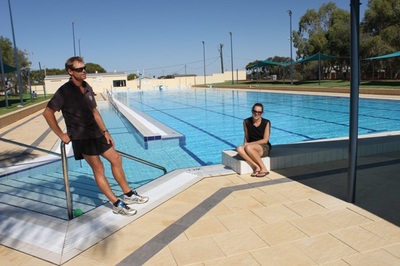
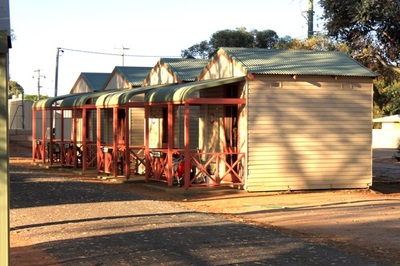
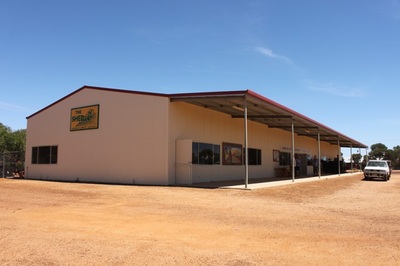
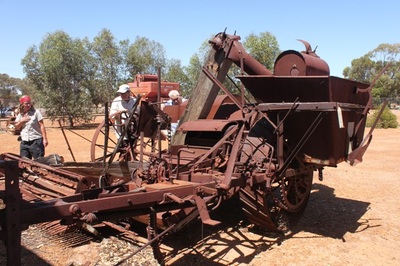
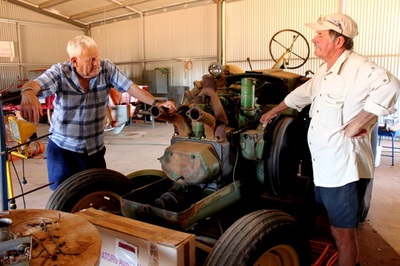
 RSS Feed
RSS Feed
